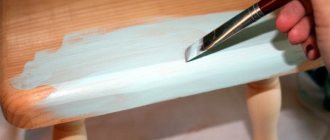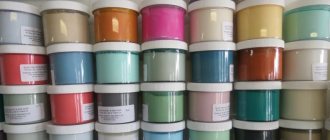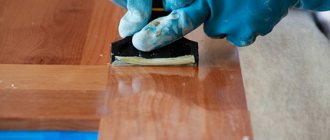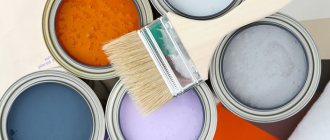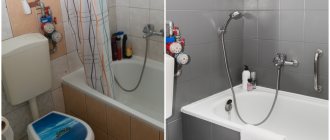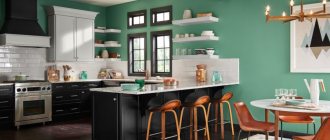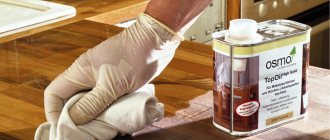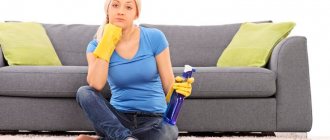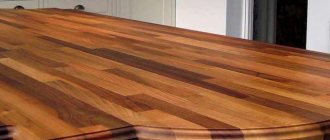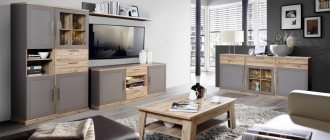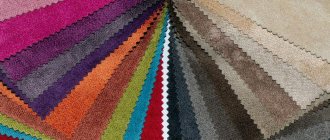When might odorless wood furniture paint be needed? When there is a desire to give new life to old cabinets, chairs, tables and give a long-boring interior a little originality and charm. Or maybe a successfully purchased uncoated chest of drawers triggers a flow of creative energy and makes you think through possible options for its transformation in your head. In both cases, you can’t do without paint for wood, and if you have to work directly in an apartment or house, then you need a special paint - odorless and drying very quickly, so as not to cause inconvenience to yourself or your loved ones.
Paints: variety of choice
Experienced craftsmen note that paints made from organic solvents have a strong odor, while aqueous emulsions have virtually no odor. It is precisely these coatings that those who want to paint furniture indoors should opt for.
Water-based coatings are becoming increasingly popular because they have a number of significant advantages, including the following:
- absence of a sharp, toxic odor;
- environmental friendliness (the composition, as a rule, contains only natural ingredients);
- Can be used on any surface;
- affordable price;
- wide range of colors;
- quick drying.
However, water emulsions are not without their disadvantages, which include the following:
- fragility (compared to coatings made using organic solvents);
- low resistance to moisture (for some craftsmen, this, by the way, is not a disadvantage, because unsuccessful work can be easily washed off with water before it dries).
But if you need to paint furniture that will be in a dry room, then a water-based coating is ideal. In addition, there are special odorless coatings that can be successfully used in damp conditions, which will be discussed further.
Color spectrum
There are several binders on the basis of which aqueous emulsions are produced, these include the following:
- acrylic;
- polyvinyl acetate;
- polymer mixture;
- latex;
- polysiloxane, etc.
What paint to choose for painting wooden furniture? Let's look at the most common options.
What it is
For an apartment you need paint that dries quickly and is odorless.
Currently, there are a variety of types of paint and varnish products in stores; they are divided according to their external characteristics and scope of use. In addition to paint and varnish products, there are various impregnations and primers for the front part of wooden products. Their correct selection and application make it possible to obtain a long-lasting and thorough coating. Note that this result is virtually impossible to achieve with ordinary or painstaking staining.
The primer composition ensures penetration into the structure of the material and its strengthening
Manufacturers produce, in addition to the main products, related materials - primers and leveling mixtures. Products must come with instructions that tell you how to prepare the surface before final painting. It happens that the tables list products specifically designed for priming.
Externally, paints are divided into the following types:
- Products with a transparent structure - varnish, glaze, impregnation agents. The fact that they contain different pigments allows you to emphasize the natural structure of the wood. These products have good vapor permeability, which is why the liquid from the treated material evaporates easily. Typically, such coatings have substances that protect against ultraviolet rays. Therefore, the tree does not deteriorate in the sun, and its service life increases. Secondary treatment is carried out after a couple of years, and the initial layer does not require removal.
Environmentally friendly wood protection products - Acrylic dispersion paints. Such coatings are widely used in repair work. Acrylates and their derivatives serve as a binder, and water is used as a solvent. The surface treated with this type of coating is reliably protected from external influences, does not fade, is moisture resistant, the liquid evaporates easily, which allows the wood to “breathe”. After painting, a film is formed, and moisture evaporates, making the material resistant to frost.
Acrylic water-dispersion paint for interior work
- When odorless wood furniture paints, using water as a solvent, began to be produced, conventional paints and varnishes became less in demand. But this does not mean that they stopped buying them. They are also used in repair work due to the quality of the coating, and they are simple and easy to use. There are several important disadvantages: they are toxic and flammable. Of the opaque enamels, which use organic solvents as a base, alkyd, vinyl chloride and polyurethane are in wide demand.
Universal waterproof alkyd enamel for interior and exterior use
On a note. Do not allow acrylic paint to freeze, this will render it unusable or most of its properties will be lost.
Advantages of acrylic paint
The most popular is acrylic paint, which dries very quickly, has no odor, is completely safe for human health and is fireproof (can significantly reduce damage from a sudden fire). This coating option can be used for any surface, including wood.
Super durable acrylic paint
Experts note that acrylic-based paint has good adhesion (for the uninitiated, adhesion) to wood surfaces and wood-based materials. These include the following materials:
- chipboard;
- OSB;
- MDF;
- plywood.
And this is quite a significant advantage, especially for those who decide to do without using a primer.
Tinting paint
Acrylic paints are white. But what if you want brightness? The solution is simple: on the shelves of construction stores you can easily find the so-called tint - a special composition, which, when mixed with paint, can give it the desired shade. Most acrylic paints contain special antiseptic additives that prevent the formation of mold and mildew, as a result of which the service life of wood furniture is significantly extended.
The modern buyer also has options for acrylic paints containing dirt- and water-repellent additives. The use of such coatings allows you to resort to cleaning wooden furniture much less often.
Tips for painting furniture
In order to paint furniture, it is not necessary to seek the help of specialists. Using the tips and instructions below, you can easily do it yourself.
Primer, like paint, can be applied to the surface in various ways - with a brush, roller or sponge.
Before you start painting furniture with your own hands, the product should be placed at a comfortable height for you.
Working with a roller provides higher productivity, but the quality of the coating will be slightly worse than when painting with a brush. It is advisable to use a roller when painting large flat surfaces.
The technology for painting furniture is as follows: a roller soaked in paint is placed on the surface to be painted and, with slight pressure, rolled several times over the same place. Stripes of paint applied with a roller should overlap one another with an overlap of 30-40 mm. Applying the paint to part of the surface in this way, it is shaded using the same roller with uniform parallel movements.
When applying paint, the brush is held with a slight inclination to the surface; it is not completely immersed in the paint, but only half the bristles. Excess paint is removed from it using the edges of the can. The paint is applied to the surface in wide stripes, light strokes, without strong pressure on the brush.
In order to clearly see the whole process, watch how furniture is painted in the video:
Latex-based water-based paint
It is believed that the best results when painting wooden surfaces can be achieved using oil paints. However, this coating has a very strong odor, and therefore is not suitable for those who want to paint furniture in comfortable conditions without harm to health.
Few people know that a similar effect can be achieved using a latex-based water emulsion. This paint easily penetrates deep into the structure of the wooden surface and creates a waterproof film. Thus, the latex water-based emulsion forms a washable coating, thanks to which dirt from the surface can be removed with a damp cloth.
Latex paint
An important advantage of latex-based water-based paint is that the drying layer has the ability to allow air to pass through, which is why you don’t have to worry about unsightly bubbles on painted furniture.
Among the disadvantages of latex coating, it is often noted that under the influence of low temperatures a network of cracks can form on it, so if the furniture that needs to be painted is located in a room that is often ventilated in winter, this is not the best option.
Peculiarities
Furniture paint must be harmless to human health. Indoor use also requires the absence of odor. Wooden surfaces should be painted to gain protection from negative environmental factors, otherwise the material will not last long. It also helps improve the decorative properties of the structure.
Regardless of what kind of wood paint for furniture you will use, it is important to properly prepare the base so that the layer is even and lasts a long time.
Glossy and varnished surfaces from old items should be completely removed, otherwise the level of adhesion will be low.
Furniture paint must be harmless to human health.
Silicone water-based paint
This coating is made on the basis of acrylic copolymer and silicone (organosilicon polymer), thanks to which this paint has the following features compared to acrylic and latex:
- resistant to abrasion and the negative effects of water;
- vapor permeable;
- very elastic (this paint can cover cracks up to 2 mm wide);
- not susceptible to damage by microorganisms;
- does not turn yellow;
- does not crack or swell;
- repels dust and dirt particles.
Silicone paint
Water-based paint based on silicone is considered one of the most durable coatings that does not have a strong odor. Typically, this coating is used for building facades, but it can also be used to paint furniture to extend the life of wood products. The use of silicone paint is especially important for transforming furniture located in damp rooms.
The only disadvantage of silicone paint is its rather high cost, but if you take into account the durability of such a coating and its other significant advantages, then this disadvantage more than pays off.
Necessary materials
So, what materials and tools will be needed at the preparation stage? Here are the most necessary ones:
- wood putty (preferably to match the color of the furniture);
- small rubber spatula;
- primer;
- sandpaper;
- brush or roller;
- masking tape.
You may also need an industrial hair dryer (if you have one) or a remover, which can be purchased at automotive stores.
Materials and tools that may be useful for the actual painting process:
- paint (we will look at what paint to paint furniture below);
- brush or roller (spray gun, sponge);
- varnish (stain);
- paint tray;
- protective equipment (respirator, goggles, gloves);
- solvent.
How to choose a manufacturer?
It is important to remember that when choosing paint you need to look for the optimal price-quality ratio. You should not chase the low cost of the purchased product, because, as you know, a stingy person will pay twice.
It is best to give preference to products from manufacturing companies that have long won a good reputation in the construction market. For domestic buyers, high-quality, odorless paints for wooden furniture are available, produced under the following brands:
- Teknos;
- Dulux;
- Tikkurila;
- Leningrad paints.
Summarizing the above, we can conclude that it is best to paint wooden furniture indoors with an odorless coating, namely water-based paints containing only natural ingredients. Water-based coating can be made on the basis of various binders, but for wooden surfaces it is preferable to use acrylic, latex or silicone paints. Acrylic paints are the most affordable, but are the least resistant to abrasion and moisture; latex-based paints are more durable, but they are still not as durable as silicone coatings, which can be used to paint wooden furniture in damp conditions. When choosing paint for coating wooden furniture, you should give preference to products from trusted manufacturers.
- Types of wood paints and their features
- How to use quick-drying odorless wood paint?
- What types of wood impregnations are there for interior work: reviews and recommendations
Compounds suitable for metal
Regardless of the processing method or the chosen type of furniture paint, you must first prepare the metal surface. Preparation consists in the fact that the metal must be completely cleaned, sanded and coated with paint using a primer. In some cases, it will be preferable to use a spray gun.
Today you can use several different techniques for painting metal furniture surfaces, for example, craquelure. With this method you can use almost any paint. First, the metal surface is cleaned with fine sandpaper and then coated with a coloring compound using a primer. After that, a special substance for cracking is applied on top of the base layer - you need to make sure that it is suitable specifically for metal. After the formation of the desired effect is completed, this layer is covered with another layer.
It is possible to add some shades of luxury to furniture objects using gilding. To obtain the maximum gilding effect, the material being processed must be completely free of dirt. Then follows the procedure of high-quality cleaning of the surface with sandpaper and covering it with several layers of paint and varnish.
